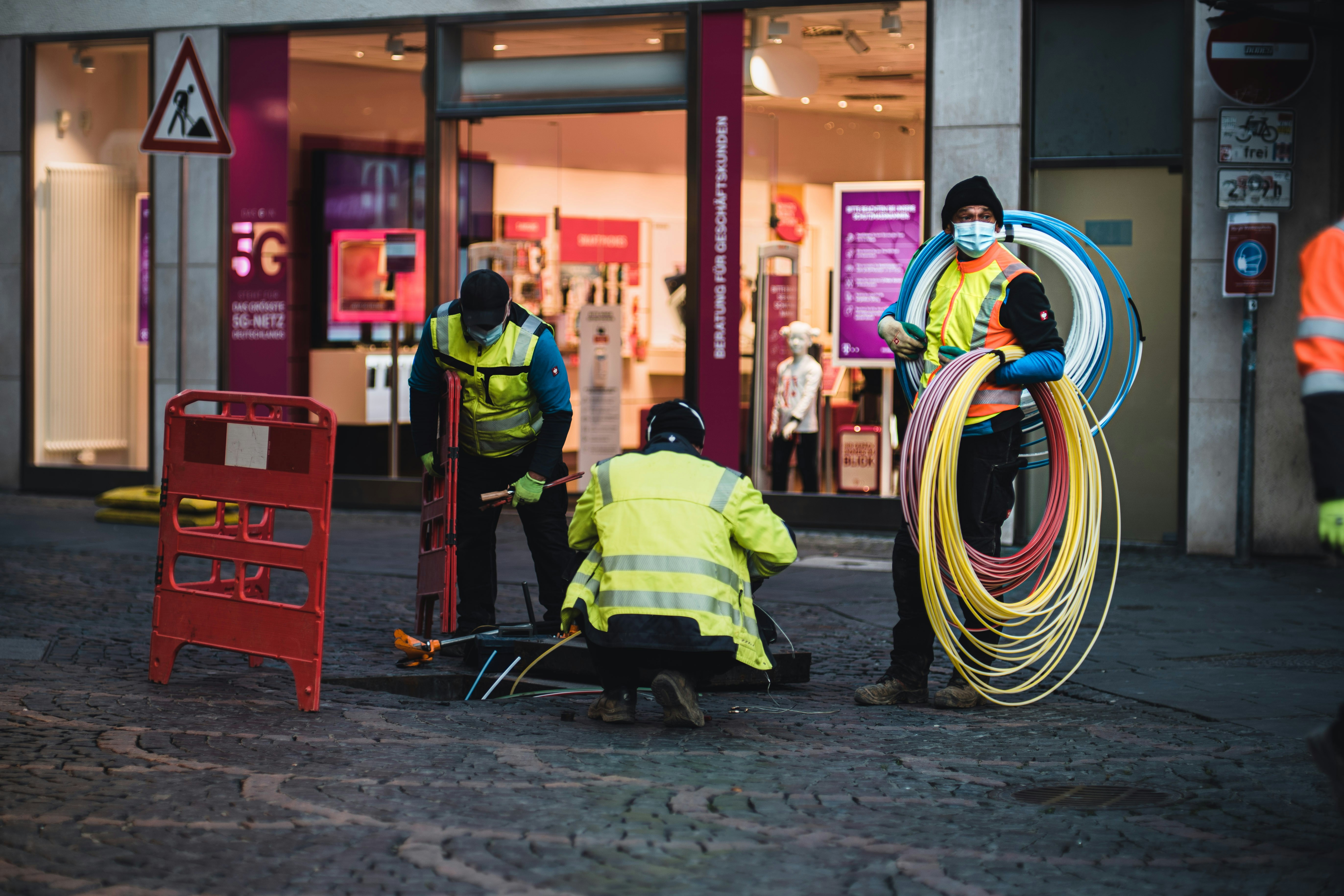A Campus Area Network, or CAN, is a specifically designed network meant to meet the connectivity needs of a large area, for example a college or university, a hospital complex or a corporate campus. The CAN provides seamless internet and intranet access by connecting multiple buildings across an extensive area. A CAN covers a much larger area than a standard LAN (Local Area NEtwork).
Why a CAN? This type of network provides a strong, reliable solution for all sorts of organisations that are spread across multiple buildings and/or campuses, providing consistent connectivity for users throughout.
What is the range and scope of a Campus Network?
In most circumstances, a CAN will cover a limited geographical area without exceeding the boundary of the campus it is serving.
They are ideal for meeting diverse needs across an organisation and can enable the integration of various technologies, e.g.
- Wi-Fi
- Fibre optics
- Ethernet
Internet opens up a wide scope of services across a campus, linking departments, and users via
- VoIP
- Video conferencing
- Secure data transfer
Do I need a LAN, WAN or CAN?
LAN – A Local Area Network is confined to a smaller area, for example, one singular building. An office building might use a LAN to connect its users.
CAN – As above, a Campus Area Network covers a larger area than a LAN, encompassing multiple buildings across a campus type site.
WAN – A Wide Area Network covers much more extensive areas; Think entire cities or even countries.
A CAN is the happy medium for a campus type site; Larger coverage than a LAN but less extensive than a WAN.
What are the main parts of a Campus Network?
The infrastructure of a CAN is what is at the heart of the network. The infrastructure of a Campus Network needs:
- Networking hardware e.g. routers, switches, firewalls
- Connectivity means ie. Fibre optic cables, ethernet cables, wireless connections
- Strategically placed Access Points to provide wide coverage
- Network services e.g. DHCP servers for dynamic IP address allocation and DNS servers for resolving network names
How do I choose the right cable and router configurations for Campus Network Connectivity?
If you want a high-performing Campus Network then selecting the appropriate cables and routers is crucial. So what factors will you need to consider?
- Cable Type: Assess the merits of fibre optic vs. Ethernet cables based on the bandwidth needs of the network and campus layout.
- Router Capabilities: Male sure that routers can handle the expected network load and offer advanced features like Quality of Service (QoS) management.
Campus Network: Do I need Fibre Optic Cables or Ethernet cabling?
When choosing between Fibre Optic cables and Ethernet cables, there are several factors to consider.
- Bandwidth Requirements: Optical fibre typically offers higher bandwidth than Ethernet.
- Distance Considerations: Fibre optic cables are better suited for longer distances without signal degradation.
- Cost Implications: Ethernet might be more cost-effective for smaller networks or shorter distances.
A Campus Area Network Needs a Backbone Network
Think of the backbone of a Campus Network as the primary pathway for data traffic. This is the main component of the whole network, connecting various subnetworks across the campus.
The CAN backbone is designed to handle high volumes of data traffic with fast and reliable data transfer across the whole Campus Network. It holds up all the daily digital interactions, connecting all users across various buildings to each other as well as vital resources.
What are the key network design strategies for optimal Campus Network performance?
There are several key strategies that can be used when designing a successful Campus Network, whether it’s a university, hospital or corporate campus.
Scalability
In order to be and stay successful, the network needs to be scalable. This means the CAN must be able to accommodate growing numbers of users and evolving technological needs. Technology and needs change all the time, and the CAN needs to be able to keep up.
Reliability
It goes without saying that a Campus Network needs to be reliable. Any downtime needs to be minimal, and any outages need to be rectified and recovered from swiftly.
Security
If users across a Campus Network are sharing data then it needs to be secure. Think sensitive academic or patient data. This data needs to be protected whilst still allowing necessary access.
Management of Bandwidth
The network load needs to be balanced and congestion minimised, particularly during peak times of usage.
CAN Infrastructure Design
The key to designing the optimal Campus Area Network infrastructure is to balance current needs with future growth. You’ll need to know:
- Campus layout
- User demands
- Technological advancements
You want a CAN that is not only strong and reliable, but able to adapt and evolve to future trends and needs.
Key Considerations:
There are several key factors to consider when planning a Campus Area Network
- User Density and Distribution: Assess and identify the number of users and their distribution across the campus to ensure network capacity meets demand.
- Application Requirements: What types of applications will the network need to support? Will they be data-intensive research applications or general administrative tasks?
- Future-Proofing: Plan for future expansions and technological upgrades.
- Budget Constraints: Balance the best possible network design with available financial resources.
Campus Networks and High-Speed Networking
Regardless of where users are located, the expectation of high-speed networking is not a luxury but an expectation. The modern academic, medical and corporate environment requires high-speed networking with an increased need for digital tools, remote working and online resources.
We live in a fast-paced, technology driven world and academic, medical and corporate spaces reflect that.
Provide a Flexible Campus Network with Wireless Solutions
Corporate, medical and academic environments increasingly require an agile campus space where the network can adapt to evolving connectivity needs.
Whether it’s students and lecturers, doctors and patients, or varying levels of corporate employees – Users need to be able to access the network from anywhere on the campus, indoors or outdoors.
Provide Consistent Coverage Across Campus With Strategic Wi-Fi AP Deployment
If you want your Campus to have comprehensive coverage, then you need to be deploying your wireless Access Points strategically.
Things to consider:
- Placing APs in high-traffic areas
- Ensuring no dead zones where connectivity drops out
- Distribution of APs to balance the network load and cater to varying user densities
- Using MU-MIMO so that several devices can connect without waiting
Should a Campus Network be Wireless or Wired?
There are of course pros and cons to both and it’s about getting the balance right between flexibility and ease of access (wireless) without compromising reliability and speed (wired).
Wireless:
- Flexible and easy to access
- Can be more susceptible to security challenges and interference
Wired:
- Reliable and fast
- Require physical infrastructure which can limit adaptability and mobility
The best Campus Network will have a good blend of both Wireless and Wired elements, using the strengths of both to provide users with a strong, flexible and reliable network.
Mobile Access on Campus Networks with Wireless Solutions
Having a Campus Network with mobile access is very much a necessity rather than a convenience. With the prevalence of smartphones, tablets and laptops among users, a CAN will require Wireless network solutions to cater for these needs with a mobile-first approach.
This doesn’t just mean that users can easily connect via these devices anywhere on campus, but that various portals and platforms are accessible and user-friendly on all types of mobile devices.
Ensuring a Campus Network is Secure
As with all networks, security is a top concern for Campus Networks too. Whether it’s sensitive academic data, patient data or employee data, all types of personal information require robust security protocols.
This includes:
- Authentication methods
- Encryption
- Regular network monitoring
- Proactive threat detection measure
The aim of a secure Campus Network is to protect against cyber threats and build trust among the users.
Campus Networks in Action: Practical Use Case in Education
The use of Campus Area Networks (CANs) enables modern education and research. We can see the practical use cases of CANs in educational settings through:
- Streamlined Administrative Operations: Automating processes like enrollment, scheduling, and student record management.
- Enhanced E-Learning: Supporting online courses, digital libraries, and virtual classrooms.
- Campus Safety: Integrating surveillance systems and emergency communication networks.
In a University setting, CANs facilitate interdisciplinary collaboration by connecting different faculties and research centres.
CANs empower and enhance collaboration between organisations and institutions via educational and corporate campuses by facilitating the engagement of innovative collaborations. Campus Networks enable video conferencing and remote collaboration tools, which in turn allows for joint ventures between institutions located in different parts of the world. The scope of this global connectivity broadens academic and professional partnerships.
In corporate campuses, Campus Networks streamline communication and data sharing by linking various departments and data centres. A Campus Network setup enhances efficiency and fosters innovation on any and all types of campus.
Transform Campus Environments with Campus Area Networks
CANs can be pivotal in transforming educational, medical and corporate campus environments into dynamic, interactive, and interconnected spaces.
In this fast-paced, technological driven world, a Campus Network facilitates more collaborative and tech-driven approaches.
Research and Development: How can a Campus Network Help?
Whether it’s in an academic environment, on a medical site or a corporate campus, all types of research and development across institutions require high-speed data transfer for inter-faculty/ department collaboration.
In this way, CANs support advanced research activities requiring large bandwidth and specialised network capabilities.
A Robust Campus Network and Resource Sharing
We live in a very data-driven world, which is why a Campus Network provides a key advantage – The ability to share large files and resources quickly and reliably.
This is essential when a campus needs to share a high-definition video, large research datasets or extensive digital libraries.
Providing a strong, reliable Campus Network means that these large files can be shared and transferred without causing problems to network performance.
The Monitoring and Maintenance of CAN Infrastructure
If you want longevity and efficiency for your Campus Network, then ongoing monitoring and maintenance is critical.
Ensure consistent connectivity and prevent network failures with:
- Regular performance checks
- Timely updates
- Proactive troubleshooting
- Training staff to manage and maintain the network effectively
Careful consideration is needed when designing an optimal Campus Area Network infrastructure. You need to think about various factors including:
- User needs
- Technological advancements
- Scalability
- Security
- Budget
Academic, medical and corporate campuses can establish strong, efficient network infrastructure tailored to their unique needs by making informed choices about cable and router configurations, and prioritising regular monitoring and maintenance.











